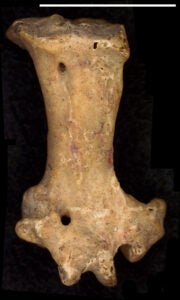2022-11-08 テキサス大学オースチン校(UT Austin)

The tarsometatarsus, or ankle bone, of a thick-billed parrot. The bone was collected at an archeological dig in New Mexico during the 1950s. UT doctoral student John Moretti identified the bone as belonging to a parrot. Credit: John Moretti/UT Jackson School of Geosciences.
この研究は、アメリカ南西部の遺跡から発見されたオウムの遺骨はすべてメキシコに起源をもつという仮定に疑問を投げかけるものである。また、この研究は重要な注意も喚起している。過去の生態系は、現在私たちが目にするものとはまったく異なるものである可能性がある。
<関連情報>
- https://news.utexas.edu/2022/11/08/old-bone-links-lost-american-parrot-to-ancient-indigenous-bird-trade/
- https://meridian.allenpress.com/wjo/article-abstract/134/3/438/484994/An-ancient-Thick-billed-Parrot-Rhynchopsitta
ニューメキシコ州南東部の古代シロハラインコ(Rhynchopsitta pachyrhyncha)とアメリカ南西部における考古学的出現のレビュー An ancient Thick-billed Parrot (Rhynchopsitta pachyrhyncha) from southeastern New Mexico with a review of archaeological occurrences in the American Southwest
John A. Moretti
The Wilson Journal of Ornithology August 15 2022
DOI:https://doi.org/10.1676/21-00078
ABSTRACT
Archaeological sites in the American Southwest contain the remains of parrots and macaws (Psittacidae). The extant geographic distribution of those species lies to the south in Mexico and Central America. As a result, the archaeological occurrence of psittacids in the American Southwest has been interpreted as the product of long-distance cultural interactions with Mesoamerica. However, unlike the tropical ecology of other species found in Southwestern sites, Thick-billed Parrots (Rhynchopsitta pachyrhyncha) are pinecone specialists inhabiting high-elevation conifer forests. The ecology and natural history of this species suggests that archaeological Thick-billed Parrots could have been obtained from naturally occurring populations within the American Southwest. Here, I document a new record of a Thick-billed Parrot from the Bonnell site in New Mexico and describe osteological features capable of distinguishing this species from other psittacids. I then review the archaeological record in order to explore hypotheses regarding the regional vs. extra-regional procurement of Thick-billed Parrots by Southwestern cultures. Skeletal remains of Thick-billed Parrots are known from 10 archaeological sites in Arizona and New Mexico dating to ∼600–1400 C.E. Sites with Thick-billed Parrots are located within or nearby montane conifer forest and/or the inhabitants of those sites engaged in economic and subsistence activities that connected them to regional montane forests. The climatic context at some sites suggests that the utilization of forest resources by past peoples coincided with potential periods of good pinecone crop production. In the 20th century, historical and reintroduced parrot flocks visited many of the same forests, demonstrating the capacity of those habitats to support Thick-billed Parrots. The relationship between archaeological Thick-billed Parrots and viable habitats supports a model of regional procurement. Thick-billed Parrots were likely present in the American Southwest, at least seasonally, throughout the late Holocene, a finding with implications for the conservation of this critically endangered species.


